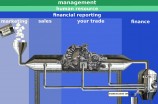(cont’d) From the 14th Century onwards the North West had a history of cloth manufacturing based mainly on wool and linen.
By the 17th century these were the main industries in the region, spinning and weaving, together with the engineering trades set up to build the necessary machinery.
The arrival of cheap cotton from the southern states of the U.S.A plus steam powered engines burning locally mined coal, powering state of the art machinery, lit the blue touch paper for an economic explosion unrivalled anywhere else in the world up to that time.
Workforce migration from Ireland accelerated by the potato famine in 1845 provided another factor of production, labour. Readily employed in the new mills and also in building the necessary transport infrastructure of canals and then railways.
The town of Manchester’s population grew from 76,000 in 1801 to 316,000 in 1851. In 1853 it became a city. The first city of the new industrial age.
The cotton produced by the new steam powered mills of the North West was cheaper and better than any cotton produced in the rest of Europe.
But by 1879, international competition from Germany and the United States provided another challenge. To remain competitive the Manchester Ship canal was built and opened in 1894.The cotton industry didn’t go into serious decline until the 1920’s. By the 1980’s it was gone.
In the early 20th century there was some diversification from the regions traditional strength in textiles, shipping and engineering to modern, hi-tech sectors including ICT, biotechnology, chemicals, pharmaceuticals, aerospace, telecommunications and financial & business services..
The de-industrialisation of the latter twentieth century hit the regional economy hard especially in the east of the region where there were large scale job losses with the end of cotton manufacturing and the closure of the engineering industries associated with it.
From the late 80’s the region became the flag ship for growth and regeneration driven by the entrepreneurial spirit of it’s people. Manufacturing was replaced by a thriving service industry.
And today with a £120 billion economy, bigger than 15 EU countries, a population of nearly seven million people and over 240,000 successful businesses, England’s North West operates on a truly international scale.
It boasts Manchester, one of the best cities in Europe to locate a business; Liverpool a city on the up and Cheshire, home to AstraZeneca’s largest global R&D centre; Lancashire, a world leader in advanced manufacturing and engineering; and Cumbria, at the international cutting-edge of nuclear technology.
With airports serving over 270 destinations worldwide, fast rail links across the UK, extensive motorway networks and a peerless technological infrastructure, it’s easy to see why England’s North West is a compelling choice for overseas business investment.




